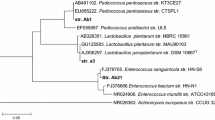Abstract
The scuticociliatid ciliates Ancistrum haliotis and A. crassum are parasites that may cause high mortality in the cultured abalone Haliotis spp. and the bivalve Ruditapes philippinarum. Traditional identification with silver staining methods is hampered by their morphological similarities to closely related species and the complicated procedures of morphological analysis. We designed two SSU rRNA-targeted oligonucleotide probes labeled with a fluorochrome, and optimized the fluorescence in situ hybridization (FISH) protocols for identification of A. halioti and A. crassum, respectively. The assays resulted in a clear identification by strong fluorescence signals from the oligonucleotide probes. The method can be used for quick and accurate quantitative analysis of A. haliotis and A. crassum infections on host molluscs.
Similar content being viewed by others
References
Behrens S, Rühland C, Inácio J, et al. 2003. In situ accessibility of small-subunit rRNA of members of the domains Bacteria, Archaea, and Eucarya to Cy3-labeled oligonucleotide probes. Applied and Environmental Microbiology, 69(3): 1748–1758, doi: https://doi.org/10.1128/AEM.69.3.1748-1758.2003
Bourne D G, Boyett H V, Henderson M E, et al. 2008. Identification of a ciliate (Oligohymenophorea: Scuticociliatia) associated with brown band disease on corals of the Great Barrier Reef. Applied and Environmental Microbiology, 74(3): 883–888, doi: https://doi.org/10.1128/AEM.01124-07
Chatton E, Lwoff A. 1949. Recherches sur les ciliés thigmotriches. Archives de Zoologie Expérimentale et Générale, 86: 169–253
DeLong E F, Wickham G S, Pace N R. 1989. Phylogenetic stains: Ribosomal RNA-based probes for the identification of single cells. Science, 243(4896): 1360–1363, doi: https://doi.org/10.1126/science.2466341
Fenchel T. 1965. Ciliates from Scandinavian molluscs. Ophelia, 2(1): 71–174, doi: https://doi.org/10.1080/00785326.1965.10409598
Giovannoni S J, DeLong E F, Oslen G J, et al. 1988. Phylogenetic group-specific oligodeoxynucleotide probes for identification of single microbial cells. Journal of Bacteriology, 170(2): 720–726, doi: https://doi.org/10.1128/JB.170.2.720-726.1988
Ludwig W, Strunk O, Westram R, et al. 2004. ARB: a software environment for sequence data. Nucleic Acids Research, 32(4): 1363–1371, doi: https://doi.org/10.1093/nar/gkh293
Medlin L, Elwood H J, Stickel S, et al. 1988. The characterization of enzymatically amplified eukaryotic 16S-like rRNA-coding regions. Gene, 71(2): 491–499, doi: https://doi.org/10.1016/0378-1119(88)90066-2
Pernthaler J, Glöckner F P, Schöenhuber W, et al. 2001. Fluorescence in situ hybridization (FISH) with rRNA-targeted oligonucleotide probes. Methods in Microbiology, 30: 207–226, doi: https://doi.org/10.1016/S0580-9517(01)30046-6
Raabe Z. 1970. Ordo Thigmotricha (Ciliata-Holotricha): II. Familia Hemispeiridae. Acta Protozoologica, 7: 117–180
Stoeck T, Taylor G T, Epstein S S. 2003. Novel eukaryotes from the permanently anoxic Cariaco Basin (Caribbean Sea). Applied and Environmental Microbiology, 69(9): 5656–5663, doi: https://doi.org/10.1128/AEM.69.9.5656-5663.2003
Wilbert N. 1975. Eine verbesserte Technik der Protargolimprägnation für Ciliaten. Mikrokosmos, 64: 171–179
Xu Kuidong, Song Weibo. 2003. Parasitic ciliates of cultured molluscs. In: Song Weibo, Zhao Yuanjun, Xu Kuidong, et al., eds. Pathogenic Protozoa in Mariculture (in Chinese). Beijing: Science Press, 115–144
Xu Kuidong, Song Weibo, Warren A. 2015. Two new and two poorly known species of Ancistrum (Ciliophora, Scuticociliatia, Thigmotrichida) parasitizing marine molluscs from Chinese coastal waters of the Yellow Sea. Acta Protozoologica, 54(3): 195–208
Zhan Zifeng, Li Ju, Xu Kuidong. 2018. Detection and quantification of two parasitic ciliates Boveria labialis and Boveria subcylindrica (Ciliophora: Scuticociliatia) by fluorescence in situ hybridization. Journal of Eukaryotic Microbiology, 65(4): 440–447, doi: https://doi.org/10.1111/jeu.12488
Zhan Zifeng, Stoeck T, Dunthorn M, et al. 2014. Identification of the pathogenic ciliate Pseudocohnilembus persalinus (Oligohymenophorea: Scuticociliatia) by fluorescence in situ hybridization. European Journal of Protistology, 50(1): 16–24, doi: https://doi.org/10.1016/j.ejop.2013.09.004
Author information
Authors and Affiliations
Corresponding author
Additional information
Foundation item: The National Natural Science Foundation of China under contract Nos 41876171 and 41406171.
Rights and permissions
About this article
Cite this article
Zhan, Z., Xu, K. Detection of two pathogenic marine ciliates Ancistrum haliotis and A. crassum (Ciliophora: Scuticociliatia) by fluorescence in situ hybridization. Acta Oceanol. Sin. 39, 90–94 (2020). https://doi.org/10.1007/s13131-020-1683-0
Received:
Accepted:
Published:
Issue Date:
DOI: https://doi.org/10.1007/s13131-020-1683-0




